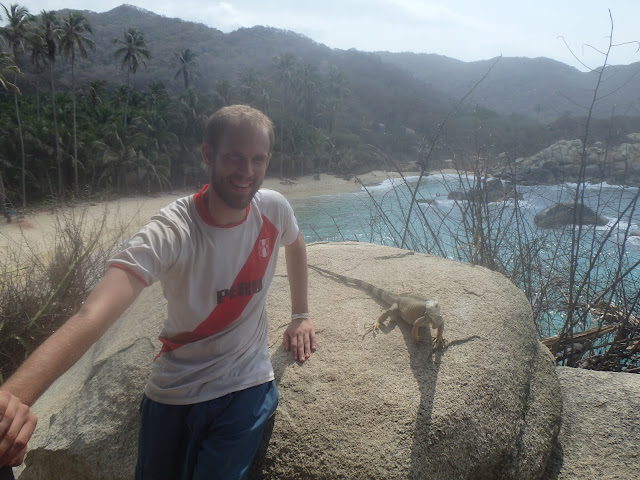2. Bogotá - Way more fun than dangerous. Our perception of Colombia as a whole is mostly wrong.
3. Machu Picchu - It lived up to what I thought would be over-hype. I went in expecting to be disappointed by the real thing. I was not.
4. Glass Frogs - They somehow managed to be a hundred times cooler than I could have ever imagined an animal being.
5. The People - Seriously, the people of all three countries are so friendly and interesting. The diversity of cultures I saw was amazing. I believe we have a lot to learn from their approach to daily life. I could say so much more here.
1. Cronuts - These are not South American, but Cusco has them and they make me very happy.
2. Sweet Arepas - A semi-sweet version of a thick tortilla-like Colombian mainstay. All arepas are good, but I consumed the sweet ones like an addict in Bogotá.
3. Fried Plantains - After so many years of banana-hating these made me decide I like bananas and all their relatives. So good!
4. Tuna (Prickly Pear Cactus fruit, not fish) - Cheap, colorful, full of hard seeds, and a great snack in a dry place. They may have affected my digestion negatively... Whatever, they are delicious.
5. Anything with Maracuyá (Passion Fruit) - Natural juices, donut fillings, alpaca steak sauce, whatever you encounter that features some form of this fruit deserves a try!
1. Vizcacha - Rock monkeys, monk rockies, chinchillas, whatever you want to call them. I think of them as high elevation rabbit-squirrels.
2. All Glass Frogs - Their massive eyes, the transparent underside... They might be aliens.
3. Bushmaster - The longest viper species in the world, known as "shushupe" by many. This thing was absolutely ridiculous beyond description, and a lucky thing for me to see.
4. Toucans - You think you have seen one after watching a Froot Loops commercial. Turns out they are tough to find, and infinitely more impressive in the wild. I had to put a bird on this list.
5. Vicuña - These relatives of the llama and alpaca just glide across the most perilous cliff faces and make funny noises to top it off.
Of course the animal list had 7 instead of 5. We all saw that one coming. To complete the top 5 lists, here are my top 5 tips for people interested in doing a similar trip in South America or elsewhere:
1. Make friends at hostels - The people you meet make your trip. This is especially important if you travel alone as I did. If an introvert like me can do this then so can you!
2. Be adventurous - Being in another country is all about seeing it for what it really is. Do things that are interesting and off the beaten path as much as you can. Gift shops and tours have their place, but finding the true essence of a place means breaking free of them. The times that I did this are my fondest memories.
3. Volunteer - Volunteer work was what brought me to South America in the first place. There are so many avenues you can take to get involved in something meaningful. The best part was that it kept me in one place long enough to really get to know where I was and who I was with.
4. EAT - Yes, you can save some money by cooking for yourself instead of going out to eat. But sometimes you must sacrifice a little cash and eat the food at the marketplace or the local restaurant. Food was a remarkably enjoyable aspect of my trip. I recommend trying everything at least once, maybe twice.
5. Learn the language - I am guilty of not studying Spanish enough during my trip. Sometimes I felt too busy to put time into it. I regret this, so learn from my mistake. The better you can communicate with locals the better your understanding of the community will be. Practice on your own time and then apply what you are learning with native speakers. Being in another country is your best chance for improving your foreign language skills!
So there you have it; some surprises, foods, animals, and advice. I hope those of you that have followed this blog have enjoyed reading what I had to say. I have had a great time writing. This blog provided me a place to share my experiences with many people without having to send tons of separate emails. That was nice. Additionally, my perfectionism forced me to put in a lot of time and thought into my writing, which I think was a valuable mental exercise. I am thankful to everyone that has read this blog, looked at the pictures, or given me feedback. For people that did not read my blog or were turned off by it, I completely understand and do not hold it against you. Sometimes I felt a little weird for talking about myself so damn much. I may or may not do a blog like this again in the future. Only time will tell. I can say for certain that the travel bug has caught on, and I have a feeling it will be a lifelong affliction! For now I am back in northern California, with a cell phone, constant internet, good beer, and warm showers once more. The readjustment is underway. Thanks again for reading!
 |
| Guinea Pigs, or cuy in Spanish |




























































